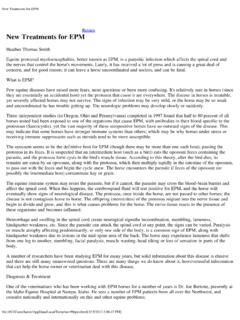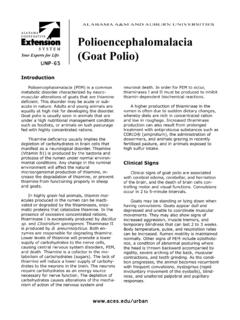Transcription of Goat Medications and How To Use Them - Equine …
1 goat Medications and How To Use Themfile:///C|/Users/Jamie/AppData/Local / [3/15/2013 2:25:54 PM]Onion Creek RanchBACK TO goat Medications & HOW TO USE THEMMost Medications used to treat goats, whether they are prescription or over the counter, are "off label" or "extra label" Medications have been specifically formulated for and approved for use with goats. Therefore, goat producers are alwayssearching for new Medications for their goats' health problems. Too much experimentation is going on with Medications withoutthe supervision of a qualified veterinarian, the most significant being the improper usage of antibiotics. Further, in many partsof this country vets know little to nothing about , the usual disclaimers. I am NOT a vet. I have been raising goats since 1990, and I have excellent vets upon whose adviceI rely and who are experienced in treating goats.
2 Use the information provided in this article at your own risk and only AFTERyou have consulted with a qualified veterinarian. The Medications are presented in alphabetical order; some of the medicationsare interchangeable with others, they provide the same treatment benefits but are being offered because specific productsmay not be available in all areas. I have not addressed withdrawal times for those producers concerned about meat and milkcontamination. Some of the products may not be approved for use in food animals; Gentamycin and Baytril (but not Baytril 100for use with cattle) in particular are restricted from usage in food animals in certain breeds and must understand that pharmaceutical companies may decide not to spend the money and time needed to get aproduct approved for use with goats because they don't see a market large enough to warrant that expenditure.
3 Lack ofgovernment approval does not necessarily mean that such products are dangerous or (donofloxacin) - Vet prescription. Injectable respiratory antibiotic (Pfizer). Neither I nor my vet have been very pleasedwith this product. Nuflor and Excenel RTU (listed hereinbelow) have worked better for Plus - Teat infusion medication containing procaine penicillin and novobiocin sodium for treating mastitis in non-lactating goats. Also used to dry up lactating mastitis treatments are more successful than using non-penicillin-based mastitis Medications . Also can be applied topically to staph (Sulfadimethoxine , or its generic equivalent) - These products are the drug of choice for preventing and treatingCoccidiosis. Give orally undiluted to kids at a rate of 3-5cc and to adults at a rate of 5-10cc for five consecutive days.
4 Mixingwith drinking water as directed on the label is another option. Will not work with automatic waterers due to continual dilution ofthe product. Sick kids should be treated individually with oral dosing for five consecutive days. Buying the gallon jug is themost cost-effective (FluMeglumine) - Vet prescription required. Anti-inflammatory that helps reduce fever, soothes irritation in thegastro-intestinal tract (gut) when diarrhea or other gut-related digestive illnesses occur, relieves pain and soreness associatedwith animal bites and other injuries. Should not be used but once daily except in severe cases where death is imminent, atwhich time the risk is worth the possible reward, because it builds up in vital organs and can cause permanent damage to theanimal in the form of ulcerations in the digestive system.
5 Dosage is 1 cc per 100 lbs. body weight IM, but can be used at a rateof 1/2 cc per 25-30 lbs body weight if necessary. A newborn kid with fever and diarrhea at Onion Creek Ranch would receivean injection of no more than 2/10 cc IM. Keeps best in hot climates when refrigerated. Never be without this 100 (Enrofloxacin 100 mg/ml) - Vet prescription. Baytril 100 (not Baytril ) is approved for use in for use in cattle in certain circumstances. Usage in goats is "off-label" or "extra-label," but this antibiotic is being usedon goats by some veterinarians. The appropriate IM dosage is 4 cc's per 100 lbs. of body weight for a minimum of 3consecutive days. Do not use the single-use dosage; goats need consecutive-day application. This medication is very effectiveagainst gut-related illnesses and works synergistically (better together than individually) with SMZ (sulfadimethoxazine withtrimethoprim).
6 Some jurisdictions prohibit use of Baytril or Baytril 100 in any form (injectable or tablets) in food-productionanimals; check with your vet. If you have a sick goat on which no other antibiotic is working, Baytril 100 is the ultimate ineffective antibiotics. Do not use without vet Creek Ranch, Lohn, TexasGoat Medications and How To Use Themfile:///C|/Users/Jamie/AppData/Local / [3/15/2013 2:25:54 PM]Biosol (Neomycin Sulfate) - Over-the-counter sulfa-based antibiotic for using with scouring kids and adults when Coccidiosis isnot the underlying illness. Works effectively against and other digestive-system bacterial infections. For kids, give 3 ccorally every 12 hours until diarrhea has stopped and feces is normal. For adult goats, use 5 cc to 10 cc orally and as directedfor usage in kids. Do not overdose; constipation can and MuSe - Vet prescriptions are required for both products.
7 ( MuSe should not be used with goats; it is too strong and isa horse medication . Use BoSe with goats.) Injectable medication for selenium deficiency. Since selenium deficiency exists atdifferent levels throughout the United States, it is critical to follow your veterinarian's directions on the usage of these products,as well as supplemental loose minerals containing selenium. See page 541 of goat Medicine, by Dr. Mary Smith, for a map ofthe United States indicating areas of selenium deficiency. Most of the East Coast, down to Florida and westward through theGreat Lakes region, plus the West Coast, including California and parts of Nevada and Idaho, are selenium deficient to differentdegrees. Selenium deficiency shows itself in goats most often in the form of weak rear legs in kids. Older goats look "pathetic,"don't put on weight, have weak legs, and generally stay in poor condition and poor health.
8 Selenium deficiency causesNutritional Muscular Dystrophy (White Muscle Disease).Selenium is toxic at low dosages, and the dosing margin of safety is narrow. The addition of selenium to feed is controlled byUS law. In some areas, producers only need to provide loose minerals containing selenium. In other regions, seleniuminjections are necessary. When injections are required, they are usually given at birth and again at one month of age (one-halfcc IM). Pregnant does usually receive injections four to six weeks before kidding, and bucks usually are vaccinated twice ayear. Adult dosage of BoSe is 2-1/2 cc per 100 lbs bodyweight given IM. It is critical that producers understand that seleniumsupplements must be determined and supervised by your veterinarian because selenium levels vary widely across the Antitoxin - Over-the-counter made-for-goats product that can be safely used for many problems.
9 Colorado Serum's C&DAntitoxin is my choice. Severe diarrhea in very young kids, toxicity caused by plants, poisons (bites, overeating disease, bloat,ruminal acidosis, and ingestion of toxic sustances like azaleas and antifreeze are several examples), one of the productsadministered to combat Floppy Kid Syndrome .. these are a few of the applications of this very versatile product which isalmost impossible to overdose. This product provides short-term protection (about 12 hours) but works quickly towards solvingthe immediate problem. Follow label directions. Always have this product on hand; there is no substitute for it. Must berefrigerated. C&D Antitoxin negates any protection previously given by the CD/T vaccine. Therefore, the producer must wait forat least five days after completion of C&D Antitoxin therapy and re-vaccinate the animal with the initial CD/T injection and thebooster 30 days thereafter.
10 This is extremely important to (Clostridium Perfringens Types C&D & Tetanus Toxoid - Tetanus Toxoid)- Over-the-counter made-for-goats product toprovide long-term protection against overeating disease (types C&D) and tetanus. Newborn kids and newly-purchased animalsshould be vaccinated with 2 cc (kids at one month of age) and then a second vaccination should be given 30 days later (kids attwo months of age). Two injections 30 days apart are required in order to provide long-term protection. Annually thereafter,one injection of 2 cc per animal will renew the protection. Give SQ. Do not be surprised if it makes a knot at the injection is the body's reaction to the vaccination, and in most cases, it eventually goes away. Colorado Serum makes a CD/Tvaccine called Essential 3+T that does not cause injection site reactions and is my choice.


